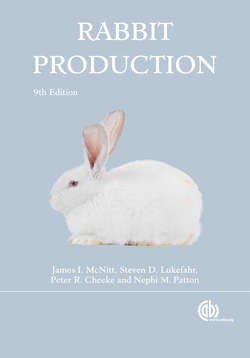Читать книгу Rabbit Production - James I McNitt - Страница 71
На сайте Литреса книга снята с продажи.
Environmental Effects on Rabbit Performance Temperature
ОглавлениеRabbits are very susceptible to heat stress because they have few functional sweat glands and have difficulty in eliminating body heat when the environmental temperature is high. Heat stressed animals stretch out to maximize body surface area for heat elimination. Animals respond differently to a sudden acute exposure to high temperature than to chronic exposure when reared under high environmental temperatures. In the tropics, rabbits can be successfully raised under conditions in which the temperature is consistently 32° to 35°C, whereas rabbits adapted to the cool conditions of the Pacific Northwest of the United States may die of heat stress when the temperature on rare occasions exceeds 32°C. Animals routinely kept under high temperatures develop metabolic mechanisms to adapt to heat stress. In areas of high temperature, such as the tropics, rabbits consume large quantities of water and consume less feed than in temperate climates. Their productivity is reduced because of the lower feed intake. Provision of adequate water is critical under these conditions. Rabbits that begin to pant or develop extreme wetness around the nose and mouth are in severe heat stress, and immediate corrective action should be taken.
An ideal environmental temperature is 10° to 15°C. This is known as the “comfort zone.” At higher or lower temperatures than this, the animal has to expend energy to maintain its body temperature. Rabbits are much more tolerant of low temperatures than high temperatures. A major consideration under low temperatures is that feed consumption is increased so the animal can maintain its body temperature. Thus, the lower the environmental temperature, the poorer the feed conversion, because a greater quantity of feed energy is being used to maintain body temperature. When limited feeding is practiced, provision must be made to provide extra feed in cold weather. It is significant that, because of the increased feed intake, water consumption also increases as the temperature drops. Restricted availability of water under cold conditions (e.g., from frozen water lines) will reduce performance more than restriction at the comfort zone, because rabbits will not eat if they don’t have sufficient water.
An interesting response to cold temperature occurs in some breeds such as the Californian, Siamese Satin, and Sable. If the newborn kits are exposed to cold temperature, or if fur on an adult is shaved and then the rabbit is exposed to cold, the fur will temporarily grow in black in areas where it is normally white (Fig. 5.21). This occurs because the cold stimulates the melanin pigment in the hair follicles, which causes the hair to be black.
Fig. 5.21. The Californian rabbit on the right had a patch of hair shaved off its rump and was then kept in a cold environment for a few days. The hair grew back in as pigmented fur. (Courtesy of OSU Rabbit Research Center)
Fluctuations in temperature may trigger outbreaks of enteritis. Enteritis outbreaks are sometimes noted following the start of a cold snap. One possibility to account for this is that a sudden drop in temperature triggers an increase in feed intake. This could cause carbohydrate overload, leading to proliferation of pathogens in the gut, with the production of lethal toxins. Restricting feed at the beginning of a cold spell may reduce the incidence of enteritis.
